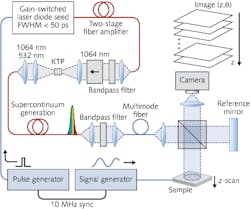Surface acoustic waves profiled by stroboscopic white-light interferometry

Surface acoustic waves (SAWs) are used by certain electronic components in mobile phones and other devices as compact filters. SAWs are generated by piezoelectric materials that operate at frequencies in the several-tens-of-megahertz to the low gigahertz range, and produce typical maximum amplitudes of a few nanometers or less. Characterizing SAWs via scanning-laser interferometry has been the conventional optical measurement approach, but an alternate technique, stroboscopic white-light interferometry (SWLI), has the advantage of being able to “freeze” vibrational motion if the illumination is synchronized to the excitation frequency of the device. However, SWLI has traditionally been limited to frequencies of a few megahertz, as well as vibrations on the order of a micrometer. Now, a group at Aalto University (Aalto, Finland) has experimentally proven a high-frequency, low-amplitude SWLI setup that can produce 3D quantitative spatial maps of SAWs.
The setup relies on a “home-built” supercontinuum white-light source in which 50 ps full-width-half-maximum (FWHM) light pulses from a laser diode are amplified in a two-stage amplifier to kilowatt-level peak powers at a 1064 nm wavelength. Part of that light is frequency-doubled by a KTP nonlinear crystal and both the 1064 and 532 nm light sent into a microstructured optical fiber to produce the supercontinuum. A 40 nm bandpass filter optimizes the spectrum of the resulting pulses for the Michelson-type interferometer. Pulse lengths were measured to be shorter than 310 ps, limited by the temporal response of the photodetector. The system was used to measure the vibration fields on a 73.728 MHz SAW device, measuring at the 72nd subharmonic to lower the optical power hitting the sample. The approximately 3-nm-amplitude SAW standing waves with an average wavelength of about 50 μm were accurately measured to a resolution of better than 100 ps. Reference: K. Kokkonen et al., Opt. Express (Apr. 20, 2015); doi:10.1364/OE.23.009690.

John Wallace | Senior Technical Editor (1998-2022)
John Wallace was with Laser Focus World for nearly 25 years, retiring in late June 2022. He obtained a bachelor's degree in mechanical engineering and physics at Rutgers University and a master's in optical engineering at the University of Rochester. Before becoming an editor, John worked as an engineer at RCA, Exxon, Eastman Kodak, and GCA Corporation.